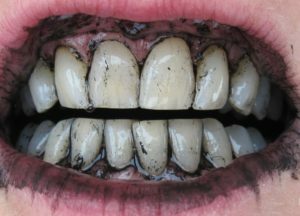 Teeth whitening with activated charcoal is a time-tested method. From time immemorial, coal is used for oral hygiene.
Teeth whitening with activated charcoal is a time-tested method. From time immemorial, coal is used for oral hygiene.
With the advent of modern means to cleanse the mouth and teeth method lost its popularity, however, those who have problems with the enamel color should adopt this simple way.
Contents of
- Action of the adsorbent on teeth
- Recipes of
- Can I carry out the procedure and is it safe?
- Reviews for use by our visitors
Action adsorbent
teeth How can be qualitatively clean tooth surface with activated carbon? This preparation is a natural adsorbent, which absorbs small particles from the surface of the enamel, thereby cleaning the teeth.
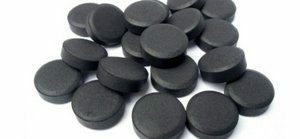 Coal has an antibacterial property that allows it to be used for deep cleansing of the oral cavity. It normalizes the acid-base balance, eliminates bad breath, serves as the prevention of caries.
Coal has an antibacterial property that allows it to be used for deep cleansing of the oral cavity. It normalizes the acid-base balance, eliminates bad breath, serves as the prevention of caries.
The whitening effect of coal is striking. Positive effect is noted with the first application. In this case, whitening with coal is considered safe and can be recommended in cases where the use of professional methods of bleaching is impossible.
enamel surface by means of coal occurs not only due to mechanical plaque removal( although this is also the case), and food dyes by neutralizing and dissolving small mineralized sediments.
Recipes of
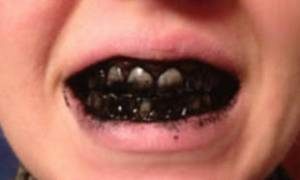 There are not many whitening recipes with activated charcoal. Traditionally, coal powder is used instead of toothpaste. To obtain a cleaning compound for the teeth, 1-2 tablets should be crushed and mixed with water: 2-3 drops are enough to make the coal powder take on a mushy consistency.
There are not many whitening recipes with activated charcoal. Traditionally, coal powder is used instead of toothpaste. To obtain a cleaning compound for the teeth, 1-2 tablets should be crushed and mixed with water: 2-3 drops are enough to make the coal powder take on a mushy consistency.
The resulting mixture is applied to a toothbrush and teeth are brushed in the usual way, paying attention to problem areas. The duration of the procedure is 5-7 minutes.
Brushing your teeth in this way should not be done often. It is recommended to conduct course procedures for 2-4 days, after which to do at least a two-week break. You can rub the powder into the teeth and gums. It is believed that such a method of purification will not only make the enamel lighter, but also strengthen the gum.
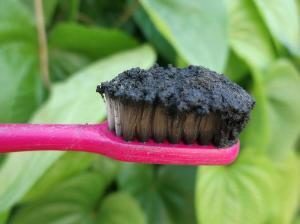 To enhance the whitening effect, it is recommended to use crushed coal powder together with toothpaste. Crushed coal can be added to the paste just before cleaning or use a special formulation for the preparation of which is taken in equal proportions of ground coal and conventional tooth powder.
To enhance the whitening effect, it is recommended to use crushed coal powder together with toothpaste. Crushed coal can be added to the paste just before cleaning or use a special formulation for the preparation of which is taken in equal proportions of ground coal and conventional tooth powder.
Those who have problems with the gums, can replace coal cleaning with coal rinses. To prepare the solution, take as many tablets of coal as necessary to obtain a thick composition. Unlike brushing with coal, rinses are less effective in bleaching, but they are safer and can be used daily.
The easiest way is to chew the activated carbon tablets. But dentists do not recommend using this method because of the high risk of enamel damage.
Is it possible to carry out the procedure and is it safe?
With a competent approach to the problem, the method can be called absolutely safe. At least, this is the most sparing way to acquire a snow-white smile from all the existing ones. Activated charcoal does not irritate the skin, does not cause serious damage to the enamel even being unground to the desired state, it is not harmful if swallowed and can be used during pregnancy and childhood.
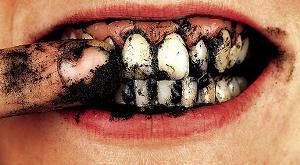 However, this method, like any other methods of whitening, is not always safe for the teeth. A non-uniform structure of the powder can damage the enamel. However, the emergence of unpleasant consequences in the form of thinning of the enamel and increase in sensitivity, preceded by serious errors on the part of patients, many of whom abuse cleaning procedures, wanting to get a quick and noticeable result. It is strictly forbidden to clean teeth with activated charcoal.
However, this method, like any other methods of whitening, is not always safe for the teeth. A non-uniform structure of the powder can damage the enamel. However, the emergence of unpleasant consequences in the form of thinning of the enamel and increase in sensitivity, preceded by serious errors on the part of patients, many of whom abuse cleaning procedures, wanting to get a quick and noticeable result. It is strictly forbidden to clean teeth with activated charcoal.
Do not brush your teeth with charcoal in the morning. It is better to carry out this procedure before going to bed. If you remove the remains of coal powder at once, you can do it in the morning before the start of the working day.
Usage reviews from our visitors
Activated charcoal bleaching is gaining more and more supporters. The relative safety of the method, its simplicity and price accessibility attract those who want to get a beautiful smile in a short time.
Decided to use coal for these purposes, because other methods in my "interesting" position could not be used. The result is very satisfied. Teeth became noticeably lighter after the third procedure. If at first I was attracted to this method only the absence of chemically harmful substances, which, for obvious reasons, are contraindicated in pregnancy, then later I appreciated this incredibly effective and cheap method that I have been using for a long time.
Angelina, Kirov
To use activated charcoal for a long time did not have enough courage. Scared the consequences in the form of damage to the enamel and non-washable remains of the coal mixture. When it came to practice, it turned out that the coal is fairly easily washed, if not immediately, then after the second rinse. No microcracks on the enamel appeared, moreover, the gum condition improved, and an unpleasant odor from the mouth disappeared.
Inna, Saratov
So many conflicting opinions I heard about brushing teeth with coal, from enthusiastic to negative, that I decided to try it myself. Immediately I will say: the effect is zero and this is after three cleaning procedures. Perhaps earlier this was the only way to painlessly brush your teeth and clarify the enamel, but now there are so many tools for high-quality cleaning at home, that I do not consider it appropriate to use doubtful methods of traditional medicine. The result of the procedures disappointed me, moreover, it was much more difficult to remove the coal particles from the interdental spaces than the plaque.
Alexey, Vitebsk
Even more reviews on this video:
